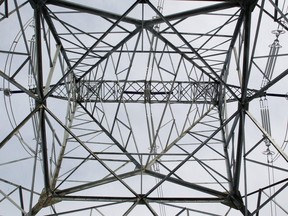Scaled down Atlantic Loop to cost $700M, and double that to Point Lepreau
Expanded connection between Salisbury, N.B., and Onslow, N.S., expected to be in service by 2029

Article content
The scaled-down version of the Atlantic Loop will cost roughly $700 million, says the head of Nova Scotia’s electric utility.
But it’s a figure that could double to $1.4 billion if the power line eventually runs to Point Lepreau.
Nova Scotia Power CEO Peter Gregg appeared in front of a legislative committee this week to provide an update on the agreement struck with the federal government late last year to ultimately scrap any immediate plan to build massive new transmission capacity that would better connect New Brunswick and Nova Scotia to Quebec.
Instead, the provinces signed a joint policy statement that will now only expand the existing connection between Salisbury, N.B., and Onslow, N.S., roughly 120 kilometres of overhead line now expected to be in service by 2029.
Added to that is a new transmission corridor that branches off and connects to the Point Lepreau substation.
The move scales down what was an $8-billion project.
“The current estimate for that project would be $700 million,” Gregg said, later stating it doubles with an additional branch line. “We continue to work with the federal government and importantly the Canada Infrastructure Bank on how we would structure that project.”
Asked specifically who pays what, Gregg said, “it’s going to take multiple parties to make this a successful and affordable journey, the (clean energy) transition.”
This month’s federal budget announced the implementation details of its clean electricity investment tax credit, what is a 15 per cent refundable tax credit rate for eligible investments in new equipment or refurbishment.
Transmission of electricity between provinces qualifies, meaning the feds will pick up at least 15 per cent of the price tag.
The infrastructure bank then has at least $20 billion earmarked for major clean electricity and clean growth infrastructure projects, that would allow the provinces to structure a project’s spending over decades at a minimal interest rate.
Gregg said the project received environmental assessment approval late last year.
“We’re now working with NB Power,” he said. “We’re into detailed engineering on that project.”
Discussions with land owners who could be impacted will also happen next.
“We’re confident we can get that delivered on time,” Gregg said of the 2029 date. “This will allow us to dispatch additional electricity as needed, providing a steady, reliable flow of energy in both directions as we add more renewables to our system.”
The project is considered a key element of Nova Scotia’s plan to close its coal plants and get 80 per cent of its energy from renewable sources by 2030.
As part of the loop deal, the feds also announced it would spend $2 million towards a feasibility study aimed at converting the Belledune coal-fired power plant to “sustainably-sourced biomass.”











Postmedia is committed to maintaining a lively but civil forum for discussion. Please keep comments relevant and respectful. Comments may take up to an hour to appear on the site. You will receive an email if there is a reply to your comment, an update to a thread you follow or if a user you follow comments. Visit our Community Guidelines for more information.